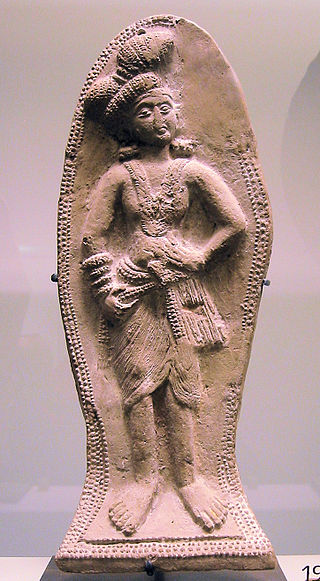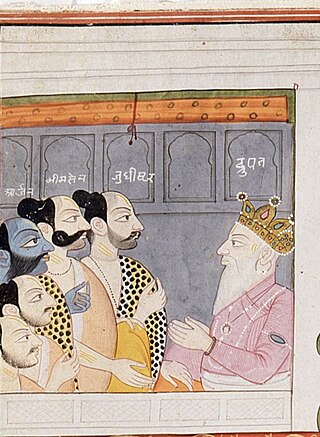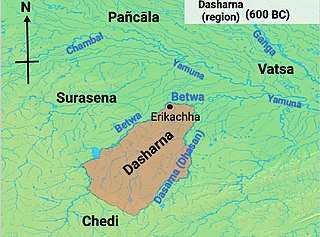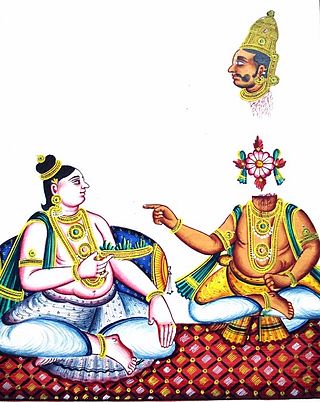Related Research Articles

Demetrius I Anicetus, also called Damaytra was a Greco-Bactrian and later Indo-Greek king, who ruled areas from Bactria to ancient northwestern India. He was the son of the Greco-Bactrian Kingdom's ruler Euthydemus I and succeeded him around 200 BC, after which he conquered extensive areas in what is now southern Afghanistan, Iran and Pakistan and India.

Sanchi Stupa is a Buddhist complex, famous for its Great Stupa, on a hilltop at Sanchi Town in Raisen District of the State of Madhya Pradesh, India. It is located, about 23 kilometers from Raisen town, district headquarter and 46 kilometres (29 mi) north-east of Bhopal, capital of Madhya Pradesh.

Magadha also called the Kingdom of Magadha or the Magadha Empire, was a kingdom and empire, and one of the sixteen Mahajanapadas, 'Great Kingdoms' of the Second Urbanization, based in southern Bihar in the eastern Ganges Plain, in Ancient India. Magadha was ruled by the Brihadratha dynasty, the Haryanka dynasty, the Shaishunaga dynasty, the Nanda dynasty, the Mauryan dynasty, the Shunga dynasty and the Kanva dynasty. It lost much of it territories after being defeated by the Satavahanas of Deccan in 28 BC and was reduced to a small principality around Pataliputra. Under the Mauryas, Magadha became a pan-Indian empire, covering large swaths of the Indian subcontinent and Afghanistan.
The Shunga dynasty was the seventh ruling dynasty of Magadha and controlled most of the northern Indian subcontinent from around 187 to 73 BCE. The dynasty was established by Pushyamitra, after taking the throne of Magadha from the Mauryas. The Shunga Empire's capital was Pataliputra, but later emperors such as Bhagabhadra also held court at Besnagar in eastern Malwa. This dynasty is also responsible for successfully fighting and resisting the Greeks in Shunga-Greek War.

Pushyamitra Shunga or Pushpamitra Shunga was the founder and the first ruler of the Shunga Empire which he established to succeed the Maurya Empire. His original name was Puṣpaka or Puṣpamitra and the confusion between Puṣyamitra and Puṣpamitra arose because of the erroneous readings of 'p' and 'y' in the manuscripts.

Brihadratha was the 9th and last Emperor of the Mauryan Empire. He ruled from 187 to 185 BCE, when he was overthrown and assassinated by his General, Pushyamitra Shunga, who went on to establish the Shunga Empire. The Mauryan territories, centred on the capital of Pataliputra, had grown considerably from the time of Ashoka to when Brihadratha came to the throne.

Dasharatha Maurya was the 4th Mauryan emperor from 232 to 224 BCE. He was a grandson of Ashoka The Great and is commonly held to have succeeded him as the Emperor of India. Dasharatha presided over a declining imperium and several territories of the empire broke away from central rule during his reign. He had continued the religious and social policies of Ashoka. Dasharatha was the last Mauryan emperor to have issued imperial inscriptions—thus the last Mauryan Emperor to be known from epigraphical sources.

Drupada, also known as Yajnasena, is the king of the southern part of Panchala Kingdom, in the Hindu epic Mahabharata. He is the father of Draupadi, the epic's lead female character. In the Kurukshetra War as the head of 1 akshauhini army, Drupada fought from the side of his sons-in-law, the Pandavas, and was killed by his childhood friend and rival, Drona.
Indraprastha is mentioned in ancient Indian literature as a city of the Kuru Kingdom. It was the capital of the kingdom led by the Pandavas mentioned in Mahabharata. Under the Pali form of its name, Indapatta, it is also mentioned in Buddhist texts as the capital of the Kuru mahajanapada. Modern historical research pin its location in the region of present-day New Delhi, particularly the Old Fort. The city is sometimes also known as Khandavaprastha or Khandava Forest, the name of a forest region on the banks of Yamuna river which had been cleared by Krishna and Arjuna to build the city.

Panchala was an ancient kingdom of northern India, located in the Ganges-Yamuna Doab of the Upper Gangetic plain. During Late Vedic times, it was one of the most powerful states of ancient India, closely allied with the Kuru Kingdom. By the c. 5th century BCE, it had become an oligarchic confederacy, considered one of the solasa (sixteen) mahajanapadas of the Indian subcontinent. After being absorbed into the Mauryan Empire, Panchala regained its independence until it was annexed by the Gupta Empire in the 4th century CE.

Bharhut is a village located in the Satna district of Madhya Pradesh, central India. It is known for its famous relics from a Buddhist stupa. What makes Bharhut panels unique is that each panel is explicitly labelled in Brahmi characters mentioning what the panel depicts. The major donor for the Bharhut stupa was King Dhanabhuti.

Avanti, was an ancient Indian Mahajanapada, roughly corresponding to the present-day Malwa region. According to the Buddhist texts, the Anguttara Nikaya, Avanti was one of the solasa mahajanapadas of the 6th century BCE. The janapada was divided into two parts by the Vindhyas, the northern part had its capital at Ujjayini and the southern part had its centre at Mahishmati.
Agnimitra was the second Shunga Emperor who reigned over what is now northern and central India. He succeeded his father, the Emperor Pushyamitra in 149 BCE. The Vayu Purana and the Brahmanda Purana have assigned 8 years as the length of his reign.
The Mālavikāgnimitram is a Sanskrit play by Kālidāsa. Based on some events of the reign of Pushyamitra Shunga, it is his first play.

Dasharna was an ancient Indian janapada (realm) in eastern Malwa region between the Dhasan River and the Betwa River. The name of the janapada was derived from the Daśārṇa, the ancient name of the Dhasan River. The janapada was also known as Akara and Rudradaman I in his Junagarh rock inscription referred to this region by this name. Kalidasa in his Meghaduta mentioned the city of Vidisha as the capital of Dasharna. Other important cities of this janapada were Erakina and Erikachha. According to the Mahabharata, the queen of king Virabahu or Subahu of Chedi kingdom and the queen of king Bhima of Vidarbha were daughters of the king of Dasharna.

Shishupala was the king of the Chedi kingdom, and an antagonist in the Mahabharata. He was the son of King Damaghosha and Srutashubha, the sister of Vasudeva and Kunti, as well as the cousin of Nanda. He was slain by Krishna, his cousin and an avatar of Vishnu, at the great coronation ceremony of Yudhishthira, as a punishment for his opprobrious abuse made against him. He is also referred to as Chaidya. Shishupala is considered to be the third and last birth of Vishnu's gatekeeper Jaya.
Vasujyeshtha or Sujyeshtha was the third Shunga Emperor who reigned over what is now Northern and Central India. He succeeded his father, the Emperor Agnimitra upon the latter's death in 141 BCE. His reign is not well documented, thus little is known about him. He is credited with successfully completing his grandfather Pushyamitra Shunga's Ashvamedha Yajna and for defeating forces of the Indo-Greek Kingdom along the banks of the Sindhu River. His achievements are mentioned briefly in the play Malavikagnimitra, which was composed during the later Gupta era by Kalidasa.
Vasumitra was the fourth Shunga Emperor, who reigned from 131 to 124 BCE. He was the son of Emperor Agnimitra by his empress-consort Dharini and the brother or half-brother of Emperor Vasujyesththa and the step son of Queen Mālavikā, the third wife of Emperor Agnimitra.

Madhav Shrihari Aney ; popularly referred to as Loknayak Bapuji Aney or Bapuji Aney, was an ardent educationist, freedom fighter, statesman, a modern Sanskrit poet and a politician. He was also conferred with the title of "Loknayak Bapuji", which means "The People's Leader and Respected Father". He was one of the founders of the Congress Nationalist Party. He was first among the eminent disciples of Lokmanya Tilak such as N C Kelkar, Kakasaheb Khadilkar, Gangadhar Deshpande, Dr B S Munje, Abhyankar, T B Paranjpe and Vaman Malhar Joshi, who walked in the footsteps of Tilak. Accepting the leadership of Mahatma Gandhi on the death of Bal Gangadhar Tilak. Aney persuaded his colleagues to see the writing on the wall. At the same time he was not blind in his loyalty. He disapproved Congress throwing itself in Khilafat Movement and warned against excessive wooing of Muslims at the cost of national interests. He regarded unity at any price as elusive and dangerous. Since the best safeguard for the minority was the goodwill of the majority. He never permitted his critical faculties to be blurred by emotion. Mahatma Gandhi admiring his calm logic, confided in him and often sought his counsel. He was chosen to arbitrate the disputes between Subhash Chandra Bose and Jatindra Mohan Sengupta. He was never a breaker or a destroyer but was always a cementing factor believing in synthesis and not in segregation.

The Bhoja tribes were a collection of semi-Aryan ancient tribes, located in India during the Late Vedic Period. They are described as being an offshoot of the Yadava tribe in the Indian epic of Mahabharata. They were a branch of the Andhaka clan, who were in turn descendants of the Satvata clan descended from King Yadu. The Bhojas were sub-divided into eighteen branches and ruled from their capital at Mrittikavati, on the banks of the Parnasa river in Central India.
References
- ↑ https://www.shabdkosh.com/dictionary/english-sanskrit/secretary/secretary-meaning-in-sanskrit
- ↑ Lahiri, Bela (1974). Indigenous States of Northern India (Circa 200 B.C. to 320 A.D.) Calcutta: University of Calcutta, pp.47-50
- ↑ Kalidas, Encyclopedia Americana